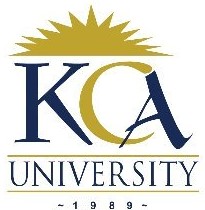 UNIVERSITY EXAMINATIONS: 2015/2016
UNIVERSITY EXAMINATIONS: 2015/2016
EXAMINATION FOR THE DIPLOMA IN NETWORK SECURITY AND
COMPUTER FORENSICS
DNF 201 COMMUNICATION SYSTEMS FUNDAMENTALS
DATE: AUGUST 2016 TIME: 1½HOURS
INSTRUCTIONS: Answer Any THREE Questions.
QUESTION ONE
a) The equipment below is found in communication systems. Describe the function of each.
[10 Marks]
i. MODEM
ii. CODEC
iii. MUX/DEMUX
iv. Repeater
v. Transponder
b) Give the parts of a communication system and their function. (Use a neat diagram to show how
information is transmitted through these parts. [6 Marks]
c) Briefly describe the hamming code as used in forward error correction [4 Marks]
QUESTION TWO
a) Define the terms digital message and digital signal. Clearly show the difference[4 Marks]
b) Give in full the acronyms [3 Marks]
i. GSM
ii. CDMA
iii. PCM
c) Briefly describe the three steps of the Analogue-to-Digital Converter (ADC) as found in the
PCM and other related equipment. (Neat block diagrams and waveform representations should
be included) [7 Marks]
d) List three applications of computer systems [3 Marks]
e) Give three advantages of digital transmission over the cheaper analogue transmission
[3 Marks]
QUESTION THREE
a) Define the following as used with data transmission
i. Signal-to-Noise Ration (SNR)
ii. modulation rate
iii. Bit-Error-Rate (BER)
iv. data rate
v. bandwidth
b) Describe the following characteristics of a carrier signal. (A neat waveform diagram should be
included)
i. frequency
ii. phase
iii. amplitude
iv. wavelength
c) Describe the following modulation methods. In each case show the resulting waveforms for a
data segment 11010001 [6 Marks]
i. FSK (frequency shift keying)
ii. ASK (Amplitude shift keying)
d) Briefly discuss the JPEG data compression mechanism [4 Marks]
QUESTION FOUR
a) Define the following communication techniques [3 Marks]
i. modulation
ii. coding
iii. multiplexing
b) Give an advantage and disadvantage of the following multiplexing methods [4 Marks]
i. FDM (frequency division multiplexing)
ii. TDM (time division multiplexing)
c) Explain two reasons that make modulation necessary in communication systems [2 Marks]
d) Describe the following types of channel noise [4 Marks]
i. white noise
ii. crosstalk
iii. inter-modulation noise
iv. impulse noise
e) Describe the following encoding methods. Also for each give an advantage and show the
encoding for the data segment 1011100 [7 Marks]
i. differential Manchester
ii. NRZ (non-return to zero)
QUESTION FIVE
a) Expand the following acronyms as used in satellite communication [4 Marks]
i. LEO
ii. GEO
iii. GPS
iv. C-band
b) Briefly outline the satellite communication system. (A sketch may be needed) [5 Marks]
c) Give two advantages of satellite systems over optical fiber [2 Marks]
d) Discuss the following error detection techniques [6 Marks]
i. checksum
ii. CRC
iii. Parity check
e) Show the LRC of the following data segment: 100010, 1010101, 1100101, 100001. Assume a
positive parity. [3 Marks]
